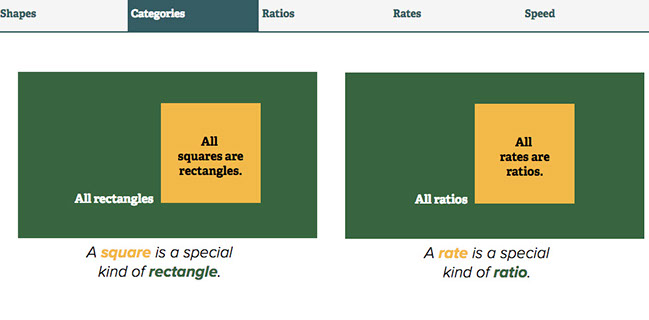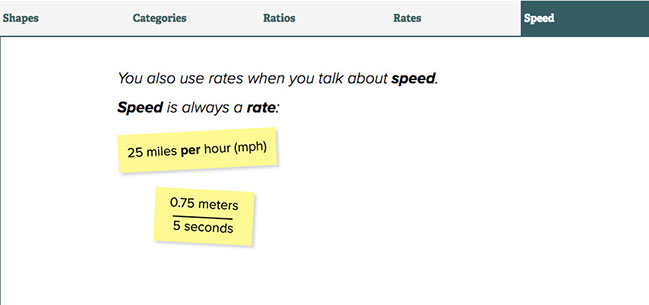SciGen Teacher Dashboard
Unit U3
The Power of Per
Side Effects of Texting
Ratio, Rate, and Percentage
Find Your Natural Walking Pace
Breathing Rate and Heart Rate Correlations
Free Throw Strategy Study
 Lesson: Ratio, Rate, and Percentage
Lesson: Ratio, Rate, and Percentage
Duration: Approximately 25 minutes
Students distinguish ratio from rate with multiple examples. Students explore the relationship between rates and ratio and percentage. The mini-lesson shows the two ways that we can express a ratio as a comparison of amounts or a comparison with a whole. The lesson also introduces the idea of a unit rate, and it ends with students converting two rates to unit rates.
LEARNING OBJECTIVES
Students understand the different uses of ratio, rate, and percentage.
Students learn the idea of a unit rate.
Students convert from non-unit rates to unit rates.
Students focus on rate of speed.
Teacher Tune-ups
Teaching Notes
ACTIVITY OVERVIEW
- Differentiate ratio and rate (5 min)
- Classify ratio and rate (10 min)
- Learn about unit rates (10 min)
Differentiate ratio and rate (5 min)





This section introduces the relationship between ratio and rate.
The mini-lesson shows the two ways that we can express a ratio. Additionally, students can see that a ratio can show both a comparison of amounts (15 girls:16 boys) or a comparison with a total (15 girls:31 students).
:
You probably know this old trick:
(Show panel: "Shapes") If you said one is a square and one is a rectangle, you’re right. And if you said they are both rectangles, you’re also right! That’s true even though the shape on the left is also a square. A square is a special kind of rectangle—one with equal side lengths.
Continue to show and discuss remaining panels (categories, ratios, rates, speed):
:
What is the gender ratio in our class?
Note: it is also correct to use a total in the comparison instead of the way it’s done above. For example: In Ms. Litton’s class there are 15 girls to 31 total students. It’s more like a simple fraction this way, but it’s still correct.
:
A rate is a special type of ratio that uses two different kinds of units together to give information. In Ms. Litton’s class, we compared the number of girls to boys—all the same unit (students). But consider a different situation: You just got a job that pays $75,000 a year. In this case, you are putting together an amount of money and an amount of time. Two totally different units. This is a rate.
In a rate, the kinds of units are different. For example, $75,000/year. One unit is money; the other unit is a period of time. Students will all recognize a speed limit and be able to identify the two different units used in this rate.
You also use rates when you talk about speed.
Speed is always a rate.
Classify ratio and rate (10 min)
Have students identify whether or not the ratio is also a rate. You may want to ask students to circle the units. If the units are different, then the ratio is also an example of a rate. The first two have been done for the students.
Answers:
- Tortoises walk about 100 feet every 5 minutes. rate (different units)
- Only three of the sodas were sugar free, and nine were regular. just a ratio
- My Internet connection can download two full-length movies in about 10 minutes. rate
- The Berkeley Yellow Jackets won 22 out of 25 games this season. just a ratio
- Famous supermodels often make $250 per hour. rate
- At the 2008 Olympics, Usain Bolt ran 100 meters in 9.69 seconds. rate
Ratio and rate: Can you tell the difference?
In the table below, mark whether each statement refers to a rate or just a ratio.
Tortoises walk about 100 feet every 5 minutes.
rate
just a ratio
Only three of the sodas were sugar free, and nine were regular.
rate
just a ratio
My internet connection can download two full-length movies in about 10 minutes.
rate
just a ratio
The Berkeley Yellow Jackets won 22 out of 25 games this season.
rate
just a ratio
Famous supermodels often make $250 per hour.
rate
just a ratio
At the 2008 Olympics, Usain Bolt ran 100 meters in 9.69 seconds.
rate
just a ratio
Learn about unit rates (10 min)
:
In a unit rate, the second unit is always equal to one, which helps to establish an easy and clear way to express the rate. Go back to the Science Scene when Giselle converted Reggie’s texting rate to a minute instead of 30 seconds. Ask students to convert the two rates to unit rates.
Answers:
- The hose leaks 0.8 gallons per hour. (The unit rate is "per hour.")
- The subway costs 2.25 per ride. (The unit rate is "per ride.")
Unit Rates: They communicate better and are easier too.

 A unit rate has a value of 1 for the second number.
A unit rate has a value of 1 for the second number.
For example, 65 miles per 1 hour is a unit rate.
So is this price for strawberries: $2.49 for 1 dry pint.
Two more examples of unit rates:

These two examples are not unit rates—yet.

Work with a partner to calculate the unit rate. Show your work.
BETA Version - Please send comments and corrections to info@serpinstitute.org